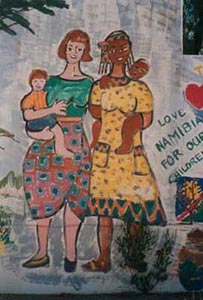 |  | ||||||
|
|||||||||||||||||
| Towards independence | |
During World War I the country was occupied by the South african troops. After the war, South Africa started to administer the country under a League Of Nations’ mandate (1920) imposing on Namibia a policy of racial segregation while pushing further the white settlement so as to increase the afrikaner-boer population. After the creation of the United Nations in 1945, South Africa refused to hand back its mandate on South-West
Africa. |
|
|
In 1964 the territory was cut into ten homelands or bantustans attributing 43% of the land to Whites who only counted at the time for 10% of the population.
|
The independence of Angola in 1975 followed by the establishment of a marxist government supported by Cuba were seen as a threat by South Africa. The namibian conflict was thus directly projected into the Cold War. The unstable areas in the North became the base for the military operations of South Africa in Angola.
|
|
 towards a blooming future in black and white? |
In 1988 agreements between South Africa, Angola and Cuba brought the ceasefire in northern Namibia and opened the gates to the country’ independence. In 1990 Namibia became independent. The SWAPO leader, Sam Nujoma, was elected president of the Republic. Independent Namibia turned its back to the apartheid policy which had been imposed for 40 years by the
south african occupant… It’s a new dawn for Namibia. |
| Top of the page | Quizz | Contact | Page updated 03.04.2004 | ||||